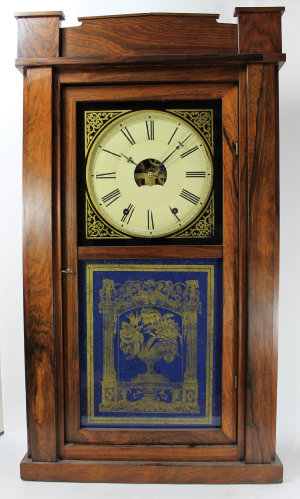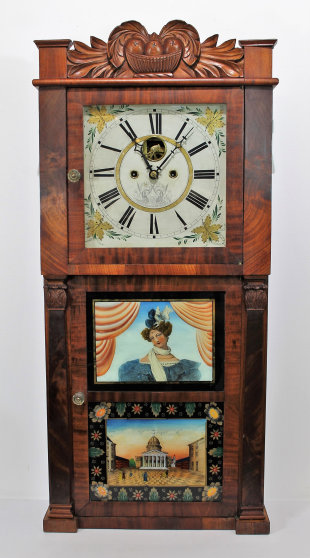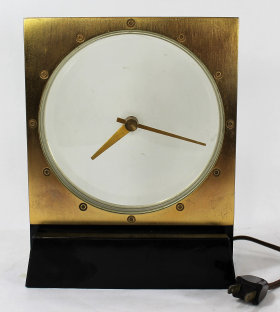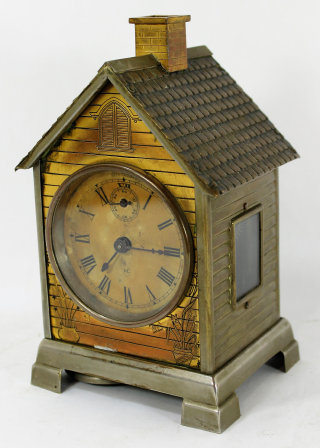

556. $200
Eight-day shelf clock, ca. 1860. This is the large version (31 inches high) of the patented
Jerome rosewood case that was utilized by a number of clock firms. The label is almost completely missing, with just a shred
at the top, not enough for us to determine the maker. The brass 8-day, weight-driven, time-and-strike movement is not signed. The rosewood-veneered case is absolutely beautiful; the metal dial repainted, period hands, and a nice dial surround reverse-painted
on the upper glass. The tablet is period, although perhaps not original to this clock; a gold vase with flowers framed in a
portico with a bright blue original background. An old pendulum bob and two new eight-day weights. The clock is running
and striking, but stops occasionally and probably needs a new bushing or two. This clock really shows well. $200-$350.
557. $1200
Hotchkiss & Benedict Empire shelf clock, 1834-1836. Clark and Thaddeus succeeded A. Munger
& Co. in Auburn NY but continued to make Munger-designed clocks in the Auburn State Prison. This impressive and refurbished
two-door, three-panel clock is 38 inches tall with a carved basket of fruit on top and two flat columns on the bottom half. The flame mahogany veneer is in outstanding shape. We assume both tablets are repainted but did not remove the wood panels that
cover them. The panels have a number of old signatures on them; both tablets are beautiful and in perfect condition, both on
old glass. The dial glass new. The dial is original and signed; the hands appropriate, and there are two correct glass
door handles. The brass, 8-day time-and-strike movement is typical with a bell strike on top, numbered 2617. The seconds
hand is the typical and unusual hand with a pointing index finger. There is an eagle pendulum bob (a Versage replacement) and
two 10-inch round compounded 8-lb weights. Three out of four of the pulleys appear to be original. The clock is running
and keeping time. A nice label inside behind a plastic protector sheet. There are only a couple of examples of Hotchkiss
& Benedict 3-panel clocks in the Antique Clocks Price Guide, and a couple more online. Typically, they have a mirror in
the lower panel. One sold last fall at Schmidt’s auction in Michigan for $1100. $1200-$1500.


558. $50
Etalage “MagiClock”, ca. 1955. The maker isn’t indicated, but these were sold by several firms
out of New York in the 1950’s. They are one of the original “mystery clocks”. There is an Haydon electric motor in the
base that turns two small gears that rotate the two concave plastic dials, one in front for the minute hand and the one in back for
the hour hand. The gears aren’t engaging the plastic disks on this clock so it is only right twice a day, but the motor is running. You might be able to get the disks to engage. The plastic disks are also a bit roughed up, and the gold finish on the case is
rough. The base that holds the motor is black plastic. You can read more about these clocks at Roger Russell’s webpage
“The clocks of Leendert Prins”. $50-$100.
559. $75
Seth Thomas “Lodge”, ca. 1900. A one-day lever movement, time and strike in a metal case, 7
inches high. The sides and roof are nickel and the front is gilt, but tarnished and worn. Two side glasses in windows
to see the movement and a paper dial, old, darkened, but signed and likely original. A seconds bit and an hour hand with a missing
tip. The clock is missing the knob to set the time, but we’ll include a key that fits the shaft. The clock is running
and keeping time, but the strike is not reliable. These come up occasionally on eBay and sell for $100-$200.
